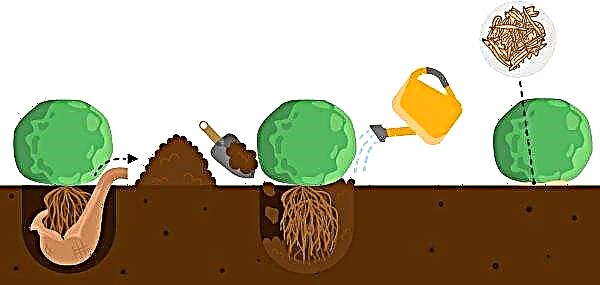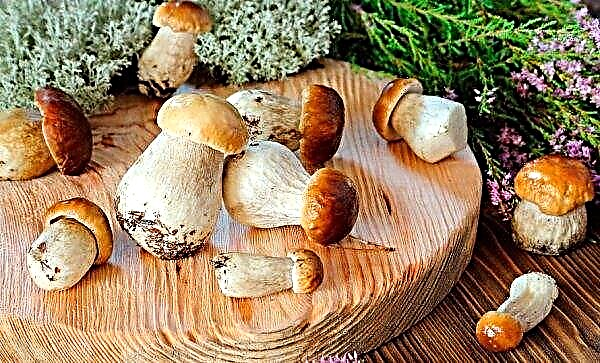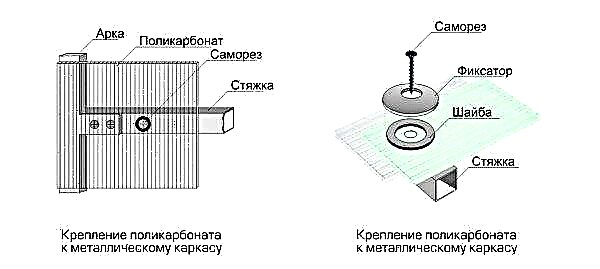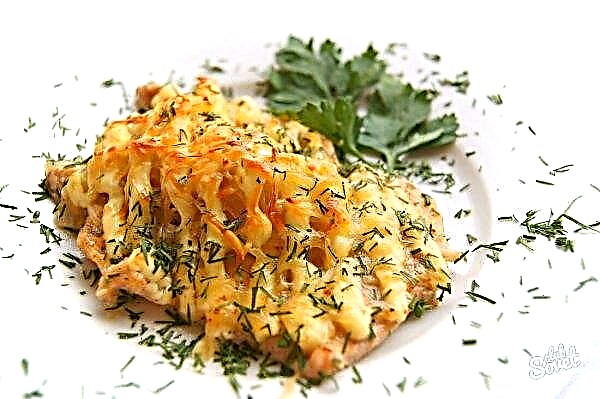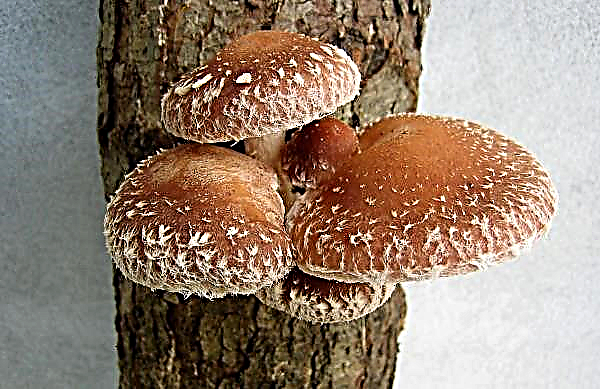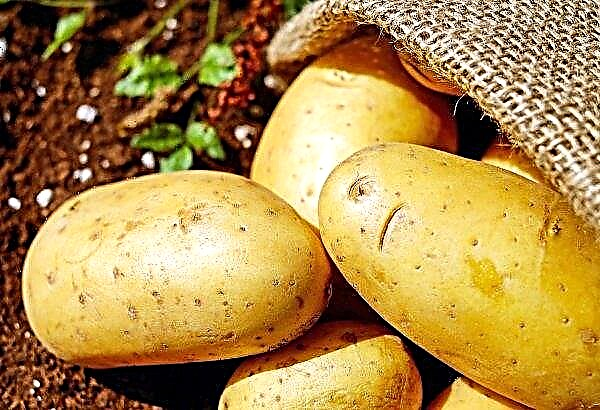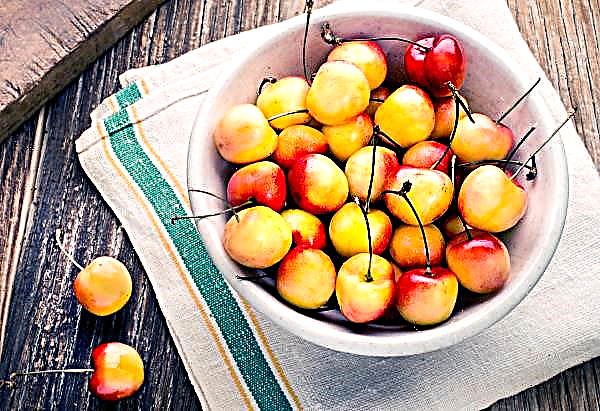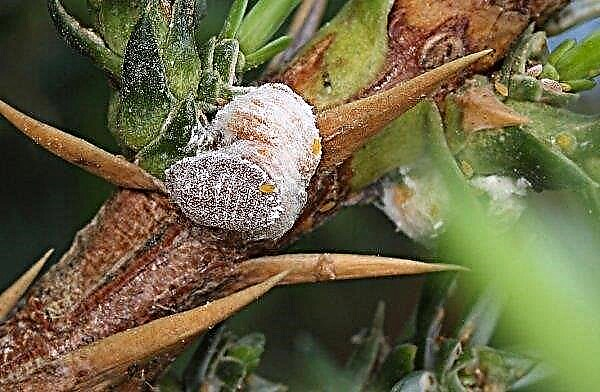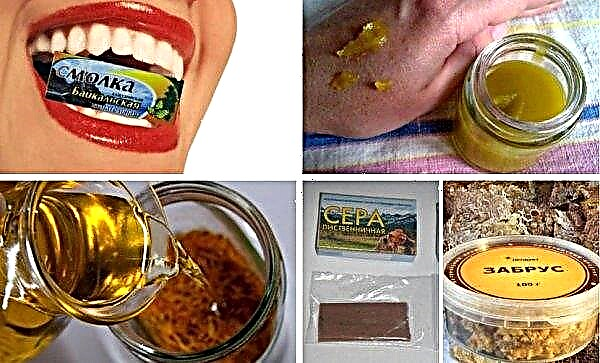Anthurium red is a beautiful decorative flowering plant, which is appreciated by florists for unusual glossy flowers and leaves. Today we will consider a detailed description of this plant, as well as the features of its cultivation at home.
Did you know? Most, about 800 species, Anthuriums grow in the wild. The flower is common in the tropical part of South America.
Botanical description of the plant
Anthurium red belongs to the genus Anthurium, numbering more than 1 thousand species. This is a grassy evergreen plant that in the wild grows on trees and has aerial roots. The flowering of anthuriums at home is almost year-round (with sufficient lighting). Flowers on the plant last at least 1.5 months.
| Root system | Well developed, long |
| Stem | Medium thickness, shortened, up to 30 cm long |
| Leaf shape | Shovel |
| Leaf color | Bright green glossy |
| Flower shape | Heart-shaped |
| Fruit shape | Round berries |
| Fruit color | Yellow or orange |
| Fruit flavor | Not eatable |
Photo gallery
House growing conditions
For normal growth and flowering, anthurium red needs certain conditions that must be created indoors.
Location
One of the main conditions for a beautiful appearance of a flower is a correctly selected placement. In the wild, anthurium grows in shady areas of the rainforest.
But in an apartment it can be grown on a window of any orientation, subject to certain nuances.:
- on the southern windows, the flower is pushed into a corner so that direct sunlight almost does not fall on it;
- on the eastern and western windows, the pot is installed close to the glass, but slightly shaded during the day;
- on the northern windows, the flower is contained only in winter, and in the summer it is transferred to a more illuminated window.
Important! In the summer, it is better to place the flower on an open balcony or street, setting the pot so that the plant is protected from strong winds and drafts.
Temperature
Anthurium is classified as heat-loving specimens: the air temperature in the room in the summer should reach + 25 ° C. If it rises higher, it is better to move the pot to a cooler place. In winter, for the normal development of the plant, it is necessary to ensure the temperature in the room at + 18–22 ° С.
Air humidity
Since in the wild Anthurium grows in the tropics, at home it needs high air humidity: the optimal level is 75%.
To maintain the necessary humidity, the flower is regularly sprayed from the spray gun or reservoirs with moist expanded clay or water are placed next to it, which release the liquid by evaporation. You can find out if there is sufficient humidity in the room by observing the flower. If drops of water independently appear on the leaves of a flower, then the humidity is at the right level.
Home Care
Like any other plant, red anthurium requires quality care in the form of regular watering, fertilizing and transplanting. Consider all the elements of care in more detail.
Important! When spraying, it is necessary to ensure that water does not fall on the flowers: from this, the flowering period can be reduced.
Watering
Watering the red anthurium should be carried out regularly, as he is very fond of moist soil. In the summer, the flower procedure is carried out 2-3 times a week, in the winter - 1 time per week.
Anthurium is watered abundantly, but it is ensured that the next layer of soil dries out by the next watering, since excessive moisture often leads to decay of the root system. To do this, use high-quality soft water at room temperature. It is pre-defended for 2 days. In addition to watering, Anthurium red responds well to regular spraying of leaves from the spray.  Also, anthurium can sometimes be rinsed from the shower, which leads not only to moisturize the leaves, but also allows you to wash off dust and pests. Rinse the leaves with a strong stream of water at room temperature: first from the front, and then from the back. When the anthurium blooms, rinsing is not carried out.
Also, anthurium can sometimes be rinsed from the shower, which leads not only to moisturize the leaves, but also allows you to wash off dust and pests. Rinse the leaves with a strong stream of water at room temperature: first from the front, and then from the back. When the anthurium blooms, rinsing is not carried out.
Top dressing
After purchasing in a store or transplanting into a new substrate with a rich composition, the anthurium can not be fed for at least 6 months. In the process of growth, the nutrient soil in the pot is depleted, and the flower may feel a lack of necessary substances.

To fill the deficit, the plant is fed with fertilizers 1 time in 2 months in the summer and 1 time per month in the winter. It is important to choose the right fertilizing, which will ensure normal flowering and building green mass. Complex fertilizers are suitable for anthurium for decorative-flowering plants during summer top dressing and on the basis of humates - during winter.
The flower in question does not respond well to an excessive amount of fertilizer, so the recommended dosage for it should be divided in half.
Pruning
Cut anthurium is necessary at the end of flowering. When the buds dry, they must be removed. Truncate peduncles with a sharp knife or scissors. Also pruned can be damaged or dry castings that spoil the appearance of the flower.
Did you know? The French botanist E. Andre was interested in anthuriums, so he went on an expedition to Colombia and Ecuador. He was able to collect 183 species of this plant, which he delivered to Europe.
Transfer
A transplant requires about 1 time in 2 years, but the annual change of soil and pot also positively affects the growth of anthuriums. For this procedure, it is worth choosing a pot 1 cm larger than the previous one, since the flower does not like much free space for the root system. If you plant a flower in a spacious flowerpot, it may stop blooming. When replanting a plant, it should be remembered that it has very fragile and delicate roots, so the procedure should be carried out with extreme caution.
The soil mixture for transplantation can be prepared independently or buy ready-made. If you have chosen the last option, then choose a substrate for begonias, in which you need to add a little coal and coconut fiber. If you are going to do it yourself, mix humus with peat in equal parts and add some pine needles, coal, pieces of broken brick.
The best time for a transplant is the spring-summer period. The plant is transplanted during the absence of flowering.
The transplant process is as follows:
- 3-5 cm expanded clay is poured on the bottom of the prepared pot to prevent further stagnation of water and decay of the roots.
- The plant is carefully removed from the pot along with an earthen lump, the roots are slightly freed from the ground and they are carefully examined. If rotten, dry, damaged or diseased roots are found, they are carefully cut with sharp scissors to living tissue.
- A little prepared soil mixture is poured onto the expanded clay layer, a plant is placed on top and the soil is carefully sprinkled to completely cover the root system.
- After transplanting anthurium into new soil, it is watered.
Video: Anthurium Transplant Secrets
Breeding
There are a lot of ways to reproduce anthurium, so everyone can choose the one that you like or seem simpler.
Seed cultivation
A fairly popular way to propagate a flower is to grow from seeds. Seeds are purchased in specialized stores. Before sowing, they are treated with any growth stimulator for decorative flowering plants. The treated seeds are sown in small containers with a mixture of peat and perlite in the grooves to a depth of 2 cm, maintaining a distance between each seed of 4 cm. After they are sprinkled with a substrate and sprayed with warm water from a spray bottle.
The container is covered with a transparent film and installed on a bright window. When germinating in a room, the temperature is maintained at + 25 ° C, they monitor the absence of drafts and sufficient lighting while maintaining a 12-hour daylight hours. You can extend the daylight hours by installing next to the capacity of the fluorescent lamp, which must be turned on when it gets dark outside.
Every day, the container must be freed from the film for 1 hour for ventilation. The soil is sprayed 2-3 times a week as the top layer dries.
After the appearance of the first seedlings (seeds germinate within a week after sowing), remove the film from the tank and continue care. When 3 leaves appear on each plant, they can be transplanted into separate plastic cups. A mixture of sphagnum and soil for azaleas is used as a substrate for transplantation, they provide good drainage (expanded clay) and make holes at the bottom of the glasses so that excess water leaves the container.
In the process of growing young plants every week they are watered with water with "Kornevin" and sprayed with "Epin" according to the instructions.
Dividing the bush
Often, anthurium is propagated by dividing the mother bush during plant transplantation. For propagation in this way, the plant is carefully removed from the pot and shake off the soil, freeing the root system. Try to untangle tangled roots carefully so as not to damage them.
Using a sharp and clean knife, divide the root into 2 parts. Cut places and damaged roots are treated with crushed activated carbon. All received parts of the plant must be planted in separate pots, following the recommendations for plant transplantation.
After transplanting, you do not need to immediately water the plants - let the slices dry out and heal a little. The first watering can be carried out a week after planting.
Cuttings
Propagation of anthurium in this way is practically not used due to the fact that cuttings placed in water for root development often rot.
If you decide to propagate anthurium with cuttings, the most favorable time for this is from May to June. When choosing, pay attention to the apical stems up to 15 cm in length: they should have 2 sheets. Cut such a stalk, keeping the maximum length.
Rooting cuttings is better in vermiculite: it is poured into plastic cups with a punctured bottom. Due to the high flowability of this substance, a piece of tissue capable of retaining vermiculite is placed on the bottom of the glass. Cuttings are buried in the soil by 5 cm, then abundantly watered with warm water. The cuttings will take root for at least 30 days, after which the plant is planted in a pot using the soil, as for transplantation.
Video: Propagation of anthurium by cuttings
Shoots
Aerial roots often appear on the anthurium, so they, along with shoots, are used to propagate the plants. To do this, stem shoots with aerial roots are separated from the plant with a sharp clean knife. Slices sprinkled with crushed coal, root parts of the plant in containers with river sand.
Over each container put on a transparent plastic bag. The greenhouse is regularly ventilated, the soil is sprayed with warm water from a spray bottle. When the plants develop additional roots and there is an active growth of green mass, they are planted in pots with the composition of the soil, as for transplantation.
Growing difficulties
Sometimes anthuriums are sick or suffer from pests, therefore, in order to save a flower, it is necessary to react in time and start treatment.
Common diseases of anthurium include:
Among the parasites that can appear on the anthurium, there are:
- thrips - appear as black dots on the back of the leaves, which are constantly in motion. For treatment, the flowers are isolated from healthy specimens and treated with any effective insecticides from the scab for decorative flowering plants according to the instructions;
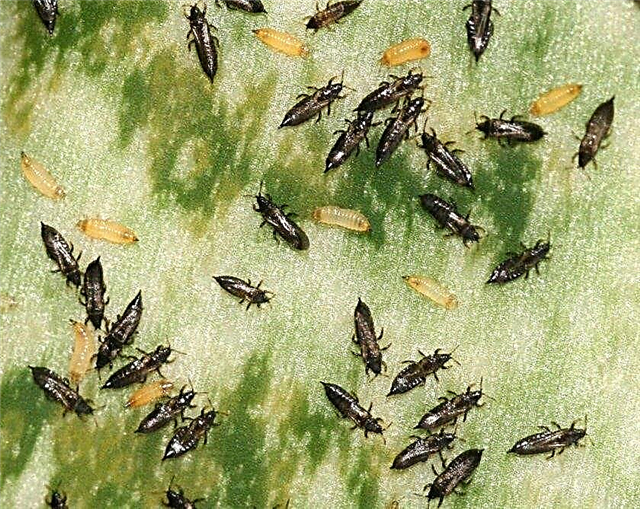
- spider mite - can be identified by a thin web, over time, the leaves curl and fade. It is necessary to treat by thoroughly washing the plants with water in the shower in order to wash off the pests. Then each sheet is treated with laundry soap, after 10 minutes it is washed off. If such a remedy does not help, treat the anthurium with a preparation for decorative flowering plants from spider mites according to the instructions;

- shield - the pest is very dangerous for the plant, since in the first stages of the defeat of the scab, it is not visible. You can identify the problem only after a time when the flower gradually begins to fade. At this time, the leaves are carefully inspected - small bulges appear on them, especially on the back side, on the veins. It is very difficult to overcome the pest, for this use the appropriate insecticides against scutes according to the instructions. During treatment, you may need to use several types of drugs.

Thus, growing red anthurium at home will not be difficult, the main thing is to adhere to the recommendations for care and maintain comfortable conditions for the plant in the room.




